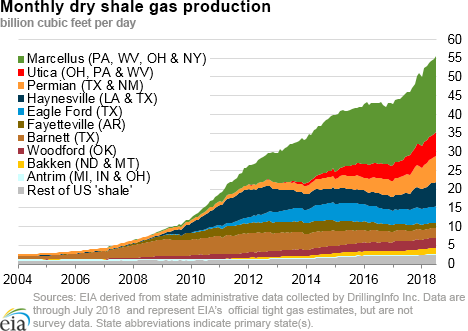In the News:
New York utility gets approval for natural gas demand response pilot program
On August 9, 2018, the New York Public Service Commission approved a petition by Consolidated Edison Company of New York, Inc. (Con Edison) for a $5 million, three-year natural gas demand response (DR) pilot program, among the first uses of DR for natural gas. Demand response programs help manage utility usage during periods of peak demand.
According to Con Edison, firm natural gas demand on its peak-day has increased by more than 30% between 2011 and 2017 and is expected to grow by an additional 23% over the next 20 years. This increase is driven by a preference for natural gas in new construction and switching from heating oil to natural gas in existing facilities. The transition resulted from a 2011 mandate to reduce use of heavy heating oil in New York City and the decline in natural gas prices since 2011.
In its pilot program, Con Edison proposed two methods of natural gas DR that closely match its existing electric DR programs. For residential and small commercial customers, it proposed using direct load control to adjust customers’ thermostats during peak natural gas demand days, with financial incentives for participation offered for up to 1,000 customers through 2021. For industrial, large commercial, and multi-family residential customers with centralized boilers, Con Edison proposed to achieve demand reductions via financial incentives alone when peak demand days are forecast. The company aims to enroll 500 new customers each year of this portion of the pilot program. Overall, Con Edison anticipates that it can meet approximately 1% of its anticipated shortfall in firm pipeline capacity with this pilot program.
Con Edison has firm pipeline transport contracts that enabled the company to meet 83% of its peak-day demand in winter 2017-18. To meet the rest of its peak-day natural gas demand, Con Edison purchases delivered services (also known as peaking contracts) from other companies. Unlike firm transport contracts, which generally have renewal rights, delivered services are not guaranteed to be available in any given year, especially if competing natural gas use elsewhere continues to increase.
Con Edison estimates that by the winter of 2023-24, its firm pipeline contracts will meet only 78% of its peak-day demand absent any new pipeline capacity. However, no remaining firm pipeline capacity is currently available into New York City or Westchester County, and recent attempts to add pipeline capacity have stalled as a result of regulatory challenges. Con Edison is now planning alternative measures, including DR, to help ensure all its customers are served on the coldest days of the year.
Although DR has become fairly common in the electricity sector over the past 10 to 15 years, programs to reduce natural gas demand have only recently been adopted. In early 2017, SoCalGas piloted the Seasonal Savings program, which used direct load control to adjust about 50,000 residential thermostats according to a household’s schedule and preferences to reduce short-term peak demand. In the winter of 2017-18, 16 National Grid customers in New York City and Long Island participated in a DR program aimed at commercial and industrial customers, where large heaters or machinery run on natural gas were turned on and off to manage peak demand days.
Overview:
(For the Week Ending Wednesday, August 22, 2018)
- Natural gas spot prices fell at most locations this report week (Wednesday, August 15 to Wednesday, August 22). Henry Hub spot prices fell slightly from $3.01 per million British thermal units (MMBtu) last Wednesday to $2.99/MMBtu yesterday.
- At the New York Mercantile Exchange (Nymex), the September 2018 contract price rose 2¢ from $2.940/MMBtu last Wednesday to $2.956/MMBtu yesterday.
- Net injections to working gas totaled 48 billion cubic feet (Bcf) for the week ending August 17. Working natural gas stocks are 2,435 Bcf, which is 22% lower than the year-ago level and 20% lower than the five-year (2013–17) average for this week.
- The natural gas plant liquids composite price at Mont Belvieu, Texas, rose by 6¢, averaging $9.00/MMBtu for the week ending August 22. The price of propane fell by 1%. The prices of ethane and isobutane both rose by 2%, and the price of butane rose by 3%. The price of natural gasoline remained flat week over week.
- According to Baker Hughes, for the week ending Tuesday, August 14, the natural gas rig count remained flat at 186. The number of oil-directed rigs remained constant at 869. The total rig count stayed at 1,057.
Prices/Supply/Demand:
Most spot prices decrease as temperatures cool. This report week (Wednesday, August 15 to Wednesday, August 22), prices fell at most price points as temperatures generally cooled. Henry Hub spot prices fell 2¢ from $3.01/MMBtu last Wednesday to $2.99/MMBtu yesterday. At the Chicago Citygate, prices decreased 10¢ from $2.95/MMBtu last Wednesday to $2.85/MMBtu yesterday.
Prices at PG&E Citygate in Northern California fell 14¢, down from $3.48/MMBtu last Wednesday to $3.34/MMBtu yesterday. Prices at SoCal Citygate decreased $2.97 from $7.89/MMBtu last Wednesday to $4.92/MMBtu yesterday. Southern California continues to experience price volatility amid ongoing maintenance and high summer electricity demand.
Prices at the Waha Hub in West Texas, which is located near Permian Basin production activities, averaged $1.95/MMBtu last Wednesday, $1.06 lower than Henry Hub prices. Yesterday, prices at the Waha Hub averaged $1.97/MMBtu, $1.02 lower than Henry Hub prices.
Northeast prices are mixed. At the Algonquin Citygate, which serves Boston-area consumers, prices went down $1.28 from $4.14/MMBtu last Wednesday to $2.86/MMBtu yesterday as regional temperatures fell from last week’s highs. At the Transcontinental Pipeline Zone 6 trading point for New York City, prices decreased 17¢ from $3.14/MMBtu last Wednesday to $2.97/MMBtu yesterday.
Appalachian spot prices rose slightly. Tennessee Zone 4 Marcellus spot prices increased 8¢ from $2.53/MMBtu last Wednesday to $2.61/MMBtu yesterday. Prices at Dominion South in southwest Pennsylvania rose 1¢ from $2.64/MMBtu last Wednesday to $2.65/MMBtu yesterday.
Nymex prices increase. At the Nymex, the price of the September 2018 contract increased 2¢, from $2.940/MMBtu last Wednesday to $2.956/MMBtu yesterday. The price of the 12-month strip averaging September 2018 through August 2019 futures contracts remained the same Wednesday to Wednesday at $2.896/MMBtu.
Supply rises as production growth continues. According to data from PointLogic Energy, the average total supply of natural gas rose by 1% compared with the previous report week. Dry natural gas production grew by 1% compared with the previous report week and averaged 82.6 Bcf/d, 14% higher than last year at this time. Average net imports from Canada decreased by 3% from last week.
Demand falls. Total U.S. consumption of natural gas fell by 1% compared with the previous report week, according to data from PointLogic Energy. Natural gas consumed for power generation declined by 3% week over week. Industrial sector consumption stayed constant, averaging 19.8 Bcf/d. In the residential and commercial sectors, consumption increased by 9% as significantly cooler-than-normal temperatures occurred in the northwest Great Plains. Temperatures below 60° Fahrenheit (°F) in parts of Montana, Wyoming, Colorado, Nebraska, and the Dakotas likely increased heating demand in the region. Residential and commercial consumption remains a relatively minor contribution to total demand during the summer months. Natural gas exports to Mexico decreased 2%.
U.S. liquefied natural gas (LNG) exports decrease week over week. Five LNG vessels (four from Sabine Pass and one from Cove Point) with a combined LNG-carrying capacity of 18.1 Bcf departed the United States from August 16 through August 22. Two LNG tankers (combined LNG-carrying capacity 7.6 Bcf) were loading at Sabine Pass on Wednesday, August 22.
Cheniere Energy, the developer of the Corpus Christi liquefaction terminal, one of the four U.S. liquefaction facilities currently under construction, has received a letter order issued by the Federal Energy Regulatory Commission granting it permission to introduce feed gas and commission dry flare as part of the commissioning activities for Train 1. The first cargo from the facility is expected to be shipped by the end of 2018, according to Bloomberg.
Storage:
Net injections are lower than the five-year average for the eighth week in a row. Net injections into storage totaled 48 Bcf for the week ending August 17, compared with the five-year (2013–17) average net injections of 52 Bcf and last year's net injections of 45 Bcf during the same week. Working gas stocks totaled 2,435 Bcf, which is 599 Bcf lower than the five-year average and 684 Bcf lower than last year at this time.
Working gas stocks are lower than the five-year range for the third week in a row. The average rate of net injections into storage is 19% lower than the five-year average so far in the 2018 refill season. If working gas stocks match the five-year average rate of injections of 10.4 Bcf/d for the remainder of the refill season, inventories will total 3,216 Bcf on October 31, which is 344 Bcf lower than the five-year low of 3,560 Bcf. In the Lower 48 states, total working gas stocks are currently 29 Bcf lower than the five-year range in the East region and 78 Bcf lower than the five-year range in the Midwest. The South Central region posted working gas stocks that are 14 Bcf higher than the bottom of the region’s five-year range, and its nonsalt facilities are 42 Bcf higher than its lower bound. Total working gas stocks in the Lower 48 states are now 142 Bcf lower than the five-year range. The last time working gas inventories were below the 2,500 Bcf threshold this late in the refill season was in 2003.
The average January 2019 futures contract price trades at a lower premium to the average spot price than last year at this time. Price differences between the spot price and the futures prices at the Nymex indicate limited economic incentives for net injections into working gas. During the most recent storage week, the average natural gas spot price at the Henry Hub averaged $2.96/MMBtu while the Nymex futures price of natural gas for delivery in January 2019 averaged $3.15/MMBtu, 19¢/MMBtu higher than the spot price. A year ago, the January contract was 38¢/MMBtu higher than the spot price.
Reported net injections into storage are close to the median of the range of analysts’ expections. According to The Desk survey of natural gas analysts, estimates of the weekly net change from working natural gas storage ranged from net injections of 43 Bcf to 55 Bcf, with a median estimate of 50 Bcf. At the 10:30 a.m. release of the Weekly Natural Gas Storage Report (WNGSR), the price of the Nymex futures contract for September delivery at the Henry Hub rose 1¢/MMBtu to $2.95/MMBtu, with 454 trades executed. Prices varied in subsequent trading, rising to $2.96/MMBtu.
Temperatures remain in the higher-than-normal range for the storage week. Temperatures in the Lower 48 states averaged 76 °F, 2°F higher than normal and 2°F higher than last year at this time. Temperatures were 2°F lower than the level reported for the previous week.
See also:
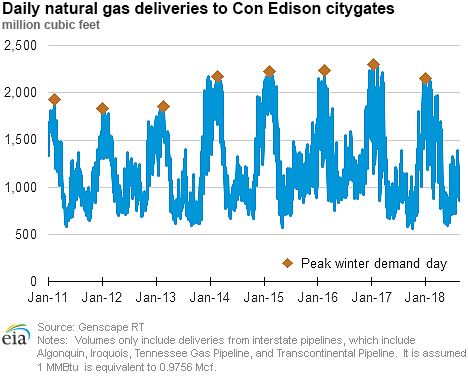
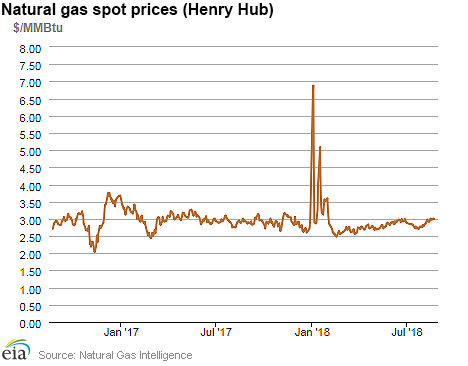
| Spot Prices ($/MMBtu) | Thu, 16-Aug |
Fri, 17-Aug |
Mon, 20-Aug |
Tue, 21-Aug |
Wed, 22-Aug |
|---|---|---|---|---|---|
| Henry Hub |
2.99 |
2.97 |
2.99 |
3.01 |
2.99 |
| New York |
3.05 |
2.88 |
3.01 |
2.98 |
2.97 |
| Chicago |
2.92 |
2.89 |
2.90 |
2.88 |
2.85 |
| Cal. Comp. Avg.* |
3.00 |
2.99 |
3.33 |
3.08 |
2.91 |
| Futures ($/MMBtu) | |||||
| September contract | 2.908 |
2.946 |
2.941 |
2.980 |
2.956 |
| October contract |
2.913 |
2.949 |
2.932 |
2.964 |
2.944 |
| *Avg. of NGI's reported prices for: Malin, PG&E Citygate, and Southern California Border Avg. | |||||
| Sources: Natural Gas Intelligence and CME Group as compiled by Bloomberg, L.P. | |||||
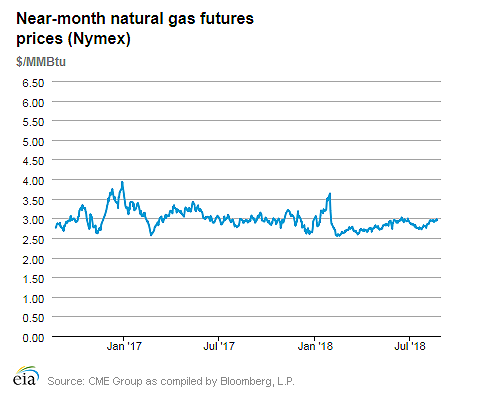
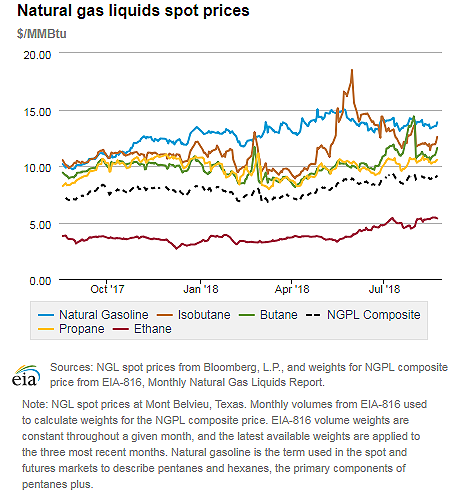
| U.S. natural gas supply - Gas Week: (8/16/18 - 8/22/18) | |||
|---|---|---|---|
Average daily values (Bcf/d): |
|||
this week |
last week |
last year |
|
| Marketed production | 93.4 |
92.6 |
81.9 |
| Dry production | 82.6 |
82.0 |
72.4 |
| Net Canada imports | 5.1 |
5.3 |
5.7 |
| LNG pipeline deliveries | 0.1 |
0.1 |
0.1 |
| Total supply | 87.8 |
87.3 |
78.2 |
|
Source: OPIS PointLogic Energy, an IHS Company | |||
| U.S. natural gas consumption - Gas Week: (8/16/18 - 8/22/18) | |||
|---|---|---|---|
Average daily values (Bcf/d): |
|||
this week |
last week |
last year |
|
| U.S. consumption | 62.3 |
62.7 |
61.7 |
| Power | 35.0 |
36.0 |
35.6 |
| Industrial | 19.8 |
19.7 |
19.5 |
| Residential/commercial | 7.5 |
6.9 |
6.6 |
| Mexico exports | 4.7 |
4.8 |
4.4 |
| Pipeline fuel use/losses | 6.7 |
6.7 |
6.6 |
| LNG pipeline receipts | 3.3 |
3.5 |
1.9 |
| Total demand | 77.0 |
77.7 |
74.6 |
|
Source: OPIS PointLogic Energy, an IHS Company | |||
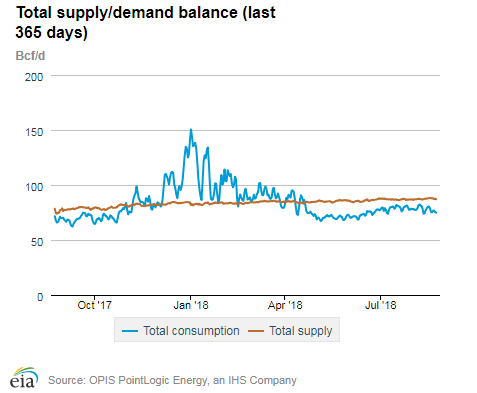
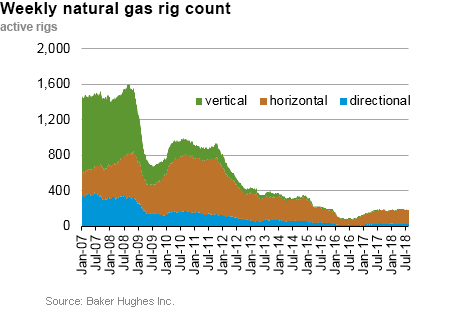
| Rigs | |||
|---|---|---|---|
Tue, August 14, 2018 |
Change from |
||
last week |
last year |
||
| Oil rigs | 869 |
0.0% |
13.9% |
| Natural gas rigs | 186 |
0.0% |
2.2% |
| Note: Excludes any miscellaneous rigs | |||
| Rig numbers by type | |||
|---|---|---|---|
Tue, August 14, 2018 |
Change from |
||
last week |
last year |
||
| Vertical | 65 |
-5.8% |
-1.5% |
| Horizontal | 922 |
-0.2% |
15.4% |
| Directional | 70 |
9.4% |
-13.6% |
| Source: Baker Hughes Inc. | |||
| Working gas in underground storage | ||||
|---|---|---|---|---|
Stocks billion cubic feet (Bcf) |
||||
| Region | 2018-08-17 |
2018-08-10 |
change |
|
| East | 613 |
592 |
21 |
|
| Midwest | 632 |
603 |
29 |
|
| Mountain | 153 |
151 |
2 |
|
| Pacific | 239 |
240 |
-1 |
|
| South Central | 798 |
801 |
-3 |
|
| Total | 2,435 |
2,387 |
48 |
|
| Source: Form EIA-912, "Weekly Underground Natural Gas Storage Report" | ||||
| Working gas in underground storage | |||||
|---|---|---|---|---|---|
Historical comparisons |
|||||
Year ago (8/17/17) |
5-year average (2013-2017) |
||||
| Region | Stocks (Bcf) |
% change |
Stocks (Bcf) |
% change |
|
| East | 724 |
-15.3 |
716 |
-14.4 |
|
| Midwest | 818 |
-22.7 |
786 |
-19.6 |
|
| Mountain | 206 |
-25.7 |
186 |
-17.7 |
|
| Pacific | 295 |
-19.0 |
321 |
-25.5 |
|
| South Central | 1,076 |
-25.8 |
1,025 |
-22.1 |
|
| Total | 3,119 |
-21.9 |
3,034 |
-19.7 |
|
| Source: Form EIA-912, "Weekly Underground Natural Gas Storage Report" | |||||
| Temperature – heating & cooling degree days (week ending Aug 16) | ||||||||
|---|---|---|---|---|---|---|---|---|
HDD deviation from: |
CDD deviation from: |
|||||||
| Region | HDD Current |
normal |
last year |
CDD Current |
normal |
last year |
||
| New England | 0 |
-3 |
-1 |
57 |
20 |
20 |
||
| Middle Atlantic | 0 |
-3 |
-2 |
66 |
15 |
22 |
||
| E N Central | 0 |
-5 |
-5 |
63 |
15 |
28 |
||
| W N Central | 0 |
-4 |
-5 |
71 |
9 |
29 |
||
| South Atlantic | 0 |
0 |
0 |
99 |
8 |
0 |
||
| E S Central | 0 |
0 |
0 |
93 |
5 |
3 |
||
| W S Central | 0 |
0 |
0 |
119 |
-4 |
-9 |
||
| Mountain | 0 |
-5 |
-3 |
81 |
11 |
11 |
||
| Pacific | 0 |
-3 |
-1 |
68 |
23 |
21 |
||
| United States | 0 |
-3 |
-2 |
80 |
11 |
14 |
||
|
Note: HDD = heating degree day; CDD = cooling degree day Source: National Oceanic and Atmospheric Administration | ||||||||
Average temperature (°F)
7-Day Mean ending Aug 16, 2018
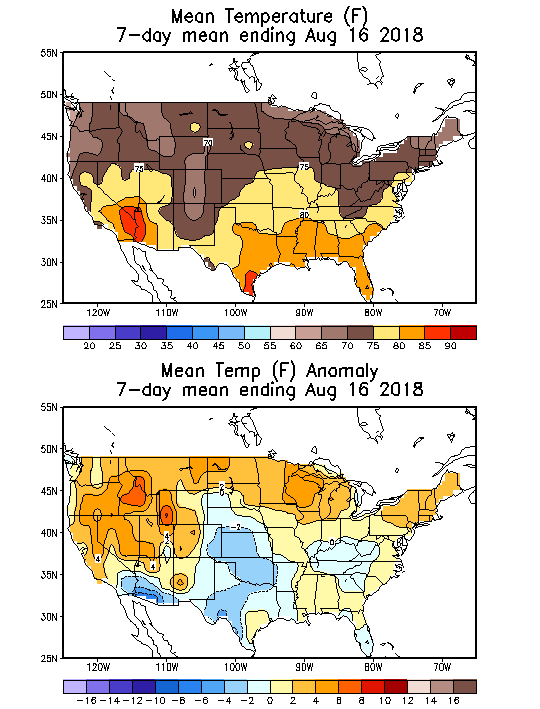
Source: NOAA National Weather Service
Deviation between average and normal (°F)
7-Day Mean ending Aug 16, 2018

Source: NOAA National Weather Service

